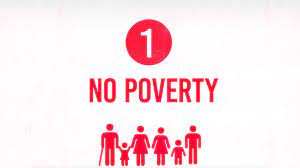The Sustainable Development Goal 1: No Poverty
One of the most pressing issues facing our world today is the eradication of poverty. The first Sustainable Development Goal (SDG) set by the United Nations is to end poverty in all its forms everywhere. This goal recognises that poverty is not just about a lack of income, but also encompasses issues such as access to basic services, education, healthcare, and opportunities for economic growth.
Despite progress in recent years, millions of people around the globe still live in extreme poverty. Achieving SDG 1 requires a comprehensive approach that addresses the root causes of poverty and promotes sustainable development for all.
Key Aspects of SDG 1:
- Economic Empowerment: Creating opportunities for income generation and decent work is essential to lift people out of poverty.
- Social Protection: Ensuring access to basic services such as healthcare, education, and social safety nets can help prevent people from falling into poverty traps.
- Sustainable Development: Promoting inclusive and sustainable economic growth is crucial for reducing inequalities and building resilience against future shocks.
The Role of Governments, NGOs, and Individuals:
Achieving SDG 1 requires coordinated efforts from governments, non-governmental organisations (NGOs), businesses, and individuals. Governments play a key role in implementing policies that promote economic growth, social protection programmes, and investment in infrastructure. NGOs provide support at the grassroots level by delivering services directly to those in need and advocating for policy changes.
As individuals, we can contribute to ending poverty by supporting ethical businesses, volunteering with organisations that work towards poverty alleviation, and advocating for policies that promote social justice and equality.
Conclusion
The Sustainable Development Goal 1 aims to create a world where no one is left behind due to lack of resources or opportunities. By working together towards this goal, we can build a more inclusive and sustainable future for all.
Understanding SDG 1: Key Targets, Descriptions, and Related Goals
- What are the targets and indicators of SDG 1?
- What is SDG 1 description?
- How many targets are there in SDG 1?
- What is the SDG 2?
- What is the SDG?
What are the targets and indicators of SDG 1?
One frequently asked question regarding Sustainable Development Goal 1 is about its targets and indicators. The targets of SDG 1 focus on eradicating extreme poverty, ensuring social protection for the vulnerable, and implementing policies to promote inclusive economic growth. Indicators for SDG 1 include the percentage of people living below the international poverty line, the coverage of social protection systems, and the proportion of men, women, and children living in poverty. Monitoring these indicators helps track progress towards achieving SDG 1 and provides valuable insights into areas that require further attention to effectively combat poverty worldwide.
What is SDG 1 description?
SDG 1, also known as Sustainable Development Goal 1, focuses on the global objective of eradicating poverty in all its forms worldwide. This goal aims to address the multifaceted nature of poverty by not only targeting income disparities but also emphasising access to essential services like education, healthcare, and economic opportunities. By setting a clear vision to end poverty everywhere, SDG 1 underscores the importance of sustainable development that uplifts individuals and communities out of poverty traps while promoting equality and social well-being on a global scale.
How many targets are there in SDG 1?
A common question regarding Sustainable Development Goal 1 is related to the number of targets it encompasses. SDG 1, which focuses on eradicating poverty in all its forms, consists of seven targets that aim to address various aspects of poverty, including economic empowerment, social protection, and sustainable development. Each target plays a crucial role in guiding efforts towards lifting individuals and communities out of poverty and ensuring a more equitable and prosperous future for all. Understanding and working towards these targets is essential in achieving the overarching goal of ending poverty worldwide.
What is the SDG 2?
Sustainable Development Goal 2 (SDG 2) focuses on Zero Hunger, aiming to end hunger, achieve food security, improve nutrition, and promote sustainable agriculture worldwide. This goal recognises the fundamental right of every individual to have access to safe, nutritious, and sufficient food. SDG 2 addresses the interconnected issues of food production, distribution, and consumption to ensure that everyone has enough food to lead a healthy and active life. By promoting sustainable agriculture practices and investing in rural infrastructure, SDG 2 aims to eliminate hunger and malnutrition in all its forms by 2030.
What is the SDG?
The Sustainable Development Goals (SDGs) are a set of global objectives established by the United Nations to address pressing challenges facing the world today. These goals encompass a wide range of issues, from poverty and inequality to climate change and sustainable development. The SDGs provide a roadmap for countries, organisations, and individuals to work towards a more equitable, prosperous, and environmentally sustainable future for all. Each goal has specific targets to be achieved by 2030, with the overarching aim of leaving no one behind and building a better world for future generations.

